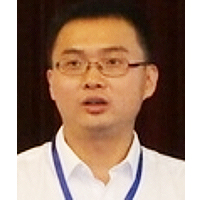Theoretical study on binding interactions of laccase-enzyme from Ganoderma weberianum with multiples ligand substrates with environmental impact
Published on: 19th December, 2019
OCLC Number/Unique Identifier: 9267261637
Laccase catalyzes oxidation of lignin and aromatic compound with similar structure to this one. Their low substrate specificity results on degradation of similar phenolic compounds. In this context, Molecular Docking was performed with different ligands suggesting potential bio-degradation. Binding active-sites prediction of fungal laccase (access number uniprotkb: A0A166P2X0), from Ganoderma weberianum was performed using machine learning algorithm based on Deep Convolutional Neural Networks (DeepSite-CNNs chemoinformatic tool). Herein, ligands like 2,4 - dichlorophenol, benzidine, sulfisoxazole, trimethoprim and tetracycline were analyzed and two additional reference controls which were 2,2 – azinobis 3 – ethylbenzothiazoline – 6 - sulfonic acid (ABTS) and 2,6 - dimetoxyphenol (2,6 DMP) were used in comparison with the other former mentioned ligands based on high laccase affinity. The five ligands were carried out because their potential biotechnological interest: the antibiotics sulfisoxazole, trimethoprim and tetracycline, and xenobiotics 2,4 - dichlorophenol and benzidine. Molecular docking experiments returned Gibbs free energy of binding (FEB or affinity) for laccase-ligand complexes. The best docking binding-interaction from each laccase-ligand conformation complexes suggest great ability of these ligands to interact with the laccase active-binding site. Herein, FEB values (kcal/mol) were obtained with higher affinity values for reference controls like 2,6 - dimethoxyphenol with -4.8 Kcal/mol and ABTS with -7.1 Kcal/mol. Furthermore, the FEB values were -4.7, -6.5, -6.8, -5.2 and -6.5 Kcal/mol, for 2,4 - dichlorophenol, benzidine, sulfisoxazole, tetracycline and trimethoprim respectively with high prevalence of hydrophobic interaction with functional laccase binding residues. Lastly, this study presents for first time at the bioinformatics field a molecular docking approach for the prediction of potential substrate of laccase from Ganoderma weberianum towards biotechnological application.
Natural Rubber Latex on Medical Applications
Published on: 6th December, 2023
In this review, latex from the Hevea Brasiliensis tree is presented as a material originating from nature, used to produce natural rubber, raw material for countless products for industry, as well as the manufacture of preservatives, and gloves, among others. Nowadays, its potential is expanding into various technological areas, one of which is biomedical, as described in this article. Latex has the possibility of being preserved using ammonium, which is a chemical of high health risk, but nowadays it is being substituted by acid systems excluding traditional chemicals. With these new preservation processes, the prospective use of latex for the design of biosensor scaffolds for drug release, and as membranes that can replace synthetic latex in patches for bioremediation in soft and bone tissues, synthetic muscles, membranes for biological micro laboratories, among others, is being studied to optimize its possibilities.
Isolation and Influence of Carbon Source on the Production of Extracellular Polymeric Substance by Bacteria for the Bioremediation of Heavy Metals in Santo Amaro City
Published on: 9th February, 2024
The city of Santo Amaro (Bahia, Brazil) gained visibility among the scientific community due to the contamination of the Subaé River by lead and cadmium from the PLUMBUM Mineração e Metalurgia Ltda industry, on the banks of the river in 1956, which produced lead ingots The present work aimed to investigate the adsorption capacity of heavy metals (Pb and Cd) of EPS produced by bacterial species from the Subaé River, for possible future application of these biopolymers in bioremediation processes in areas impacted by the aforementioned heavy metals. Subaé river water was collected for physical-chemical analysis and bacterial isolation. It was verified that all isolated bacteria produced an expressive amount of Exopolysaccharide (EPS). Thus, the optimization of this production in different sugars (sucrose, glucose, and mannitol) and in three different pHs: 5.5; 6.5, and 7.5. All bacteria produced EPS in large quantities and the best sugar was sucrose at pH 7.5. In order to use the EPS for the bioremediation area, the adsorption test of lead and cadmium was carried out by the isolated EPS. 0.5 g of the EPS was dissolved in 50 ml of deionized water, then the solutions of metals, lead acetate, and cadmium sulfate (procedure performed separately) were incubated at 28 °C for 16 h after that period, and were centrifuged. Samples were filtered to separate the insoluble EPS and the filtrates obtained were used in the quantification of the metals by atomic absorption (FAAS- Flame Atomic Absorption Spectrometry). Bacillus spp., Bacillus cereus, Staphylococcus spp., and Serratiamarcescens, all showed tolerance to the tested metals, due to the efficiency in the adsorption capacity of the EPS, and it was possible to distinguish seven genera, Klebsiella pneumonia, Pseudomonas aeruginosa, Lysinibacillus spp. to be used in the bioremediation of environments contaminated with heavy metals.




